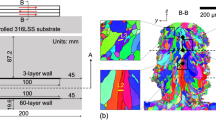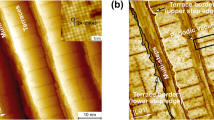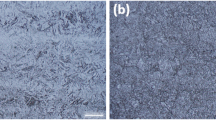Abstract
IN a recent communication1, T. Tokumitu concludes that the naturally occurring oxide film on stainless steels is ±-(Fe,Cr)2O3, and he bases this conclusion upon the fact that heating the natural oxide layer to 600° C. for one hour suffices to change the electron diffraction pattern from one of blurred rings which cannot be analysed, to a well-defined pattern of ±-(Fe,Cr)2O3. The crystalline structure adopted by the film on heating, however, may very well be different from that of the natural oxide, and even the chemical composition may be changed, since, unless the heating is carried out in an exceedingly good vacuum or its equivalent, the film may gain oxygen, and also, as Pfeil2 has shown in the case of thick scales, diffusion of metal atoms towards the oxide surface occurs at high temperatures.
This is a preview of subscription content, access via your institution
Access options
Subscribe to this journal
Receive 51 print issues and online access
$199.00 per year
only $3.90 per issue
Buy this article
- Purchase on Springer Link
- Instant access to full article PDF
Prices may be subject to local taxes which are calculated during checkout
Similar content being viewed by others
References
Tokumitu, T., NATURE, 145, 589 (1940).
Pfeil, J. Iron and Steel Inst, No. 1, 501 (1929).
Jackson and Quarrell, Second Report of the Alloy Steels Research Committee, Special Report No. 24, Section 4, Iron and Steel Institute, 1939.
Author information
Authors and Affiliations
Rights and permissions
About this article
Cite this article
QUARRELL, A. Oxide Films on Alloy Steels. Nature 145, 821–822 (1940). https://doi.org/10.1038/145821b0
Issue Date:
DOI: https://doi.org/10.1038/145821b0
Comments
By submitting a comment you agree to abide by our Terms and Community Guidelines. If you find something abusive or that does not comply with our terms or guidelines please flag it as inappropriate.



